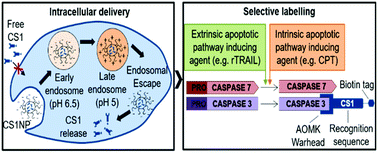Development of an advanced nanoformulation for the intracellular delivery of a caspase-3 selective activity-based probe†
Abstract
The ability to label active caspase-3 represents a useful pharmacodynamic strategy to determine the efficacy of anti-tumour drugs. Activity-based probes (ABPs) provide a method for the labelling of activated caspases and the recent development of hybrid combinatorial substrate libraries (HyCoSuL) has allowed for the generation of highly selective ABPs to discriminately label these proteases. Here using this approach, a novel caspase-3 selective ABP (CS1) has been developed and validated in apoptotic cells to selectively bind caspase-3 over the closely related caspase-7. However, a critical bottleneck for ABPs is their cell penetrance and therefore this cell-impermeable CS1 probe was subsequently formulated into PLGA-based nanoparticles (CS1-NPs). We demonstrate the ability of these particles to be taken up by the cells and facilitate intracellular delivery of the ABP to effectively label caspase 3 in response to apoptotic stimuli. This work forms the foundation of a novel approach for the labelling of caspase 3 and may have downstream utility to measure real time apoptosis in tumours and other organs.



 Please wait while we load your content...
Please wait while we load your content...